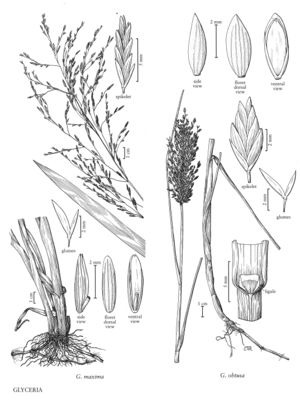Difference between revisions of "Glyceria obtusa"
FNA>Volume Importer |
FNA>Volume Importer |
||
| Line 17: | Line 17: | ||
-->{{Treatment/Body | -->{{Treatment/Body | ||
|distribution=Maine;Md.;N.J.;Mass.;N.Y.;N.H.;Del.;D.C;N.C.;S.C.;Va.;Pa.;Conn.;R.I.;N.B.;N.S. | |distribution=Maine;Md.;N.J.;Mass.;N.Y.;N.H.;Del.;D.C;N.C.;S.C.;Va.;Pa.;Conn.;R.I.;N.B.;N.S. | ||
| − | |discussion=<p>Glyceria obtusa is a distinctive species that grows in wet woods, swamps, and shallow waters, primarily on the eastern seaboard of North America, from Nova Scotia and New Brunswick to South Carolina.</p> | + | |discussion=<p><i>Glyceria obtusa</i> is a distinctive species that grows in wet woods, swamps, and shallow waters, primarily on the eastern seaboard of North America, from Nova Scotia and New Brunswick to South Carolina.</p> |
|tables= | |tables= | ||
|references= | |references= | ||
| Line 26: | Line 26: | ||
-->{{#Taxon: | -->{{#Taxon: | ||
name=Glyceria obtusa | name=Glyceria obtusa | ||
| − | |||
|authority=(Muhl.) Trin. | |authority=(Muhl.) Trin. | ||
|rank=species | |rank=species | ||
| Line 34: | Line 33: | ||
|family=Poaceae | |family=Poaceae | ||
|illustrator=Cindy Roché | |illustrator=Cindy Roché | ||
| + | |illustration copyright=Utah State University | ||
|distribution=Maine;Md.;N.J.;Mass.;N.Y.;N.H.;Del.;D.C;N.C.;S.C.;Va.;Pa.;Conn.;R.I.;N.B.;N.S. | |distribution=Maine;Md.;N.J.;Mass.;N.Y.;N.H.;Del.;D.C;N.C.;S.C.;Va.;Pa.;Conn.;R.I.;N.B.;N.S. | ||
|reference=None | |reference=None | ||
| Line 39: | Line 39: | ||
|publication year= | |publication year= | ||
|special status= | |special status= | ||
| − | |source xml=https:// | + | |source xml=https://jpend@bitbucket.org/aafc-mbb/fna-data-curation.git/src/f50eec43f223ca0e34566be0b046453a0960e173/coarse_grained_fna_xml/V24/V24_84.xml |
|subfamily=Poaceae subfam. Pooideae | |subfamily=Poaceae subfam. Pooideae | ||
|tribe=Poaceae tribe Meliceae | |tribe=Poaceae tribe Meliceae | ||
Revision as of 21:24, 16 December 2019
Plants perennial. Culms 60-100 cm tall, 2.5-5 mm thick, often decumbent at the base. Sheaths glabrous, smooth, not keeled, midvein prominent; ligules 0.5-0.8 mm, not translucent, truncate to slightly rounded; blades 15-40 cm long, 2-8 mm wide, abaxial surfaces smooth, adaxial surfaces scabridulous. Panicles 5-15 cm long, 2.5-6 cm wide, ovoid, erect, dense; branches 2.5- 8 cm, strongly ascending, with 10-30 spikelets; pedicels 1-14 mm. Spikelets 4-7 mm long, 2.5-4 mm wide, somewhat laterally compressed, oval in side view, with 4-7 florets. Glumes keeled, 1-veined, veins not extending to the apical margins, apical margins hyaline, acute, entire or often splitting with age; lower glumes 1.6-2.5 mm, lanceolate to narrowly ovate or obovate; upper glumes 1.7-3.5 mm, ovate-elliptic to obovate, obtuse to rounded; rachilla internodes 0.2-0.4 mm; lemmas 3-3.9 mm, 5-9-veined, veins not raised, apices rounded, somewhat prow-shaped; paleas subequal to the lemmas, lengths 2-2.8 times widths, keels well-developed, not winged, tips pointing towards each other, narrowly notched between the keels; anthers 2, 0.6-0.8 mm. Caryopses 1.5-1.8 mm. 2n = 40.
Distribution
Maine, Md., N.J., Mass., N.Y., N.H., Del., D.C, N.C., S.C., Va., Pa., Conn., R.I., N.B., N.S.
Discussion
Glyceria obtusa is a distinctive species that grows in wet woods, swamps, and shallow waters, primarily on the eastern seaboard of North America, from Nova Scotia and New Brunswick to South Carolina.
Selected References
None.
